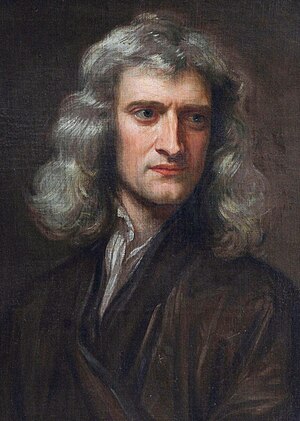 Newton’s discovery in Optics was equally impressive of his work in Motion and Gravitation. His publication of the results of his experiments and studies called Opticks in 1704 was the groundbreaking work to understand how color works and how we see colors. Newton’s discoveries explained why bodies appear to be colored. They laid the foundation for the science of spectrum analysis. This science allows us to determine the chemical composition, temperature, and even the speed of such hot, glowing bodies as a distant star or an object heated in a laboratory.
Newton’s discovery in Optics was equally impressive of his work in Motion and Gravitation. His publication of the results of his experiments and studies called Opticks in 1704 was the groundbreaking work to understand how color works and how we see colors. Newton’s discoveries explained why bodies appear to be colored. They laid the foundation for the science of spectrum analysis. This science allows us to determine the chemical composition, temperature, and even the speed of such hot, glowing bodies as a distant star or an object heated in a laboratory.Newton discovered that sunlight is a mixture of light of all colors in the spectrum of the rainbow. He passed a beam of sunlight through a prism and studied the colors that were produced. Newton was the first to demonstrate that a prism cannot divide monochromatic light into a rainbow, as does white light. Newton also invented the color wheel. He put the pure hues of the spectrum of the outside and shaded them into gray at the center. In another theory he used was that if the green sweater were lighted by a red light or any color light not containing green, it would not appear green. Newton first observed a series of alternately bright and dark circles that could be seen when a slightly convex piece of glass is placed against a flat piece of glass. If the viewing light is a single color, the rings will have this color. If the light is white, the rings will have the colors of the spectrum from violet through red. Newton’s Rings are caused by interference between the light waves reflected from the top of the flat surface and those reflected from the bottom of the curved surface. The point of the contact is dark.
The study of light led Newton to consider constructing a new type of telescope in which a reflecting mirror was used instead of a combination of lenses. Newton’s fist reflecting telescope was 6 inches long, and, through it, Newton saw Jupiter’s satellites. The largest reflecting telescope in the world today is at Palomar Observatory in California.
The Three-Component Theory developed from Newton’s work. In 1801, the English physicist Thomas Young suggested that the eye has kinds of color sensitivities. He believed that these sensitivities respond to what he called red, green, and violet light. Young later modified his theory and declared that nature has three basic sensations–red, green, and violet–that cause all colors. Then Hermann von Helmholtz improved on Young’s theory. He published his work in 1867 and made th three-component theory was the basis for nearly all later work in color science. To honor both men, scientists called it the Young-Helmholtz Theory. It has been widely accepted by physicists because it fits well with other theories about the behavior of light. In 1860, James Clerk Maxwell, the Scottish physicist was the first man to measure and define the spectrum accurately. The following year while trying to prove Young’s theory Maxwell publicly produced the first color photograph.
SHORT BIO: Isaac Newton
Born: Dec. 25, 1642 at Woolsthorpe, Lincolnshire, England.
Attended: Grantham grammar school. Entered Trinity College, Cambridge University, in 1661. Graduated in 1665. Returned to Cambridge as a fellow of Trinity College in 1667. He became a professor of mathematics in 1669. He lectured in geometry, astronomy, optics, arithmetic, and other mathematical subjects. He was elected a fellow of the Royal Society in 1672. He became the Cambridge University member of Parliament in 1689. He became warden of the mint in 1696. He was the master of the mint in 1699. He resigned from Cambridge in 1701 to enter government service in the mint and settled permanently in London. He became president of the Royal Society in 1703. Queen Anne knighted Newton in 1705.
Personal Characteristics: Newton was a bachelor who spent little time studying mathematics, physics, and astronomy. He was a student of alchemy. He spent a great deal of time on questions of theology and Biblical chronology. He had many nephews and nieces and was very generous towards them as he was with publishers and scientists who helped him in his work.
Died: March 20, 1727, buried in Westminster Abbey. His last words, “I do not know what I may appear to the world, but to myself I seem to have been only like a boy playing on the seashore, and diverting myself in now and then finding a smoother pebble or a prettier shell than ordinary, whilst the great ocean of truth lay all undiscovered before me.”
Admirers: Albert Einstein although he didn’t agree with Newton’s explanation of universal gravitation but not the fact of its operation. Einstein said his own work would have been impossible without Newton’s discoveries. He said that the concepts of Newton “are even today guiding our thinking in physics.”
REF:
History of Color
Light
©2007. Teresa Carr. Skyhouse Communications & Mega Grafx Studio.
Related articles by Zemanta
- Isaac Newton's apple tree off to spaaaace (go.theregister.com)
- How the Vineyards Fare (rosewoodhillfarm.com)
- Piece of Isaac Newton's tree to defy gravity by going into space (news.bbc.co.uk)
- Isaac Newton's apple tree to experience zero gravity - in space (guardian.co.uk)
- 'Sir Isaac would have loved to see this, assuming he wasn't spacesick' (dvice.com)
- Astronauts Give Isaac Newton a Zero G Tribute (space.com)
- Isaac Newton and Physics for Kids (wired.com)


No comments:
Post a Comment